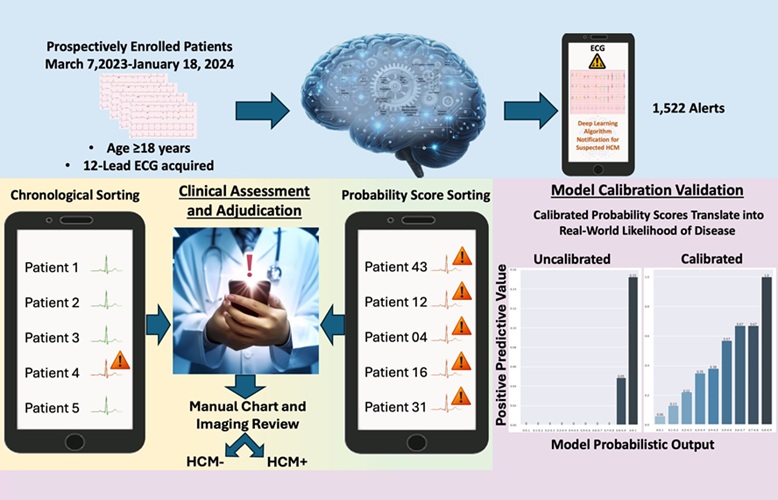Mind-Controlled Robotic Arm Benefits Paralyzed Patients
|
By HospiMedica International staff writers Posted on 03 Jul 2019 |

Image: New research suggests mind-controlled robotics can aid the paralyzed (Photo courtesy of CMU).
A noninvasive brain-computer interface (BCI) allows a mind-controlled robotic arm to continuously track and follow a computer cursor, using only thoughts.
Developed by researchers at Carnegie Mellon University (CMU; Pittsburgh, PA, USA) and the University of Minnesota (UMN; Minneapolis, USA), the new BCI facilitates real-time continuous robotic device control by increasing user engagement and spatial resolution of noninvasive neural data through electroencephalogram (EEG) source imaging, accompanied by a continuous pursuit task and an associated training paradigm. In all, the framework enhanced BCI learning by nearly 60% for traditional center-out tasks, and by more than 500% in the more realistic continuous pursuit task.
The researchers further demonstrated an additional enhancement in BCI control of almost 10% by using online noninvasive neuroimaging. The framework was also deployed in a physical task, demonstrating a near-seamless transition from the control of an unconstrained virtual cursor to the real-time control of a robotic arm. The researchers claim that combining advances in the quality of neural decoding with the accessibility of noninvasive robotic arm control will have a major role in the future development and implementation of neurorobotics. The study was published on June 19, 2019, in Science Robotics.
“There have been major advances in mind controlled robotic devices using brain implants. It's excellent science, but noninvasive is the ultimate goal,” said senior author Professor Bin He, PhD, head of the department of biomedical engineering at CMU. “This work represents an important step in noninvasive brain-computer interfaces, a technology which someday may become a pervasive assistive technology aiding everyone, like smartphones.”
Direct electrical stimulation and recording of brain activity requires invasive procedures, such as the removal of a portion of the skull or the drilling of a burr hole. Also, electrode implantation into tissue can cause inflammatory tissue responses and brain trauma, and lead to device failure. A noninvasive counterpart requiring less intervention could profoundly improve the integration of BCIs into the clinical and home setting.
Related Links:
Carnegie Mellon University
University of Minnesota
Developed by researchers at Carnegie Mellon University (CMU; Pittsburgh, PA, USA) and the University of Minnesota (UMN; Minneapolis, USA), the new BCI facilitates real-time continuous robotic device control by increasing user engagement and spatial resolution of noninvasive neural data through electroencephalogram (EEG) source imaging, accompanied by a continuous pursuit task and an associated training paradigm. In all, the framework enhanced BCI learning by nearly 60% for traditional center-out tasks, and by more than 500% in the more realistic continuous pursuit task.
The researchers further demonstrated an additional enhancement in BCI control of almost 10% by using online noninvasive neuroimaging. The framework was also deployed in a physical task, demonstrating a near-seamless transition from the control of an unconstrained virtual cursor to the real-time control of a robotic arm. The researchers claim that combining advances in the quality of neural decoding with the accessibility of noninvasive robotic arm control will have a major role in the future development and implementation of neurorobotics. The study was published on June 19, 2019, in Science Robotics.
“There have been major advances in mind controlled robotic devices using brain implants. It's excellent science, but noninvasive is the ultimate goal,” said senior author Professor Bin He, PhD, head of the department of biomedical engineering at CMU. “This work represents an important step in noninvasive brain-computer interfaces, a technology which someday may become a pervasive assistive technology aiding everyone, like smartphones.”
Direct electrical stimulation and recording of brain activity requires invasive procedures, such as the removal of a portion of the skull or the drilling of a burr hole. Also, electrode implantation into tissue can cause inflammatory tissue responses and brain trauma, and lead to device failure. A noninvasive counterpart requiring less intervention could profoundly improve the integration of BCIs into the clinical and home setting.
Related Links:
Carnegie Mellon University
University of Minnesota
Latest Patient Care News
- Portable Biosensor Platform to Reduce Hospital-Acquired Infections
- First-Of-Its-Kind Portable Germicidal Light Technology Disinfects High-Touch Clinical Surfaces in Seconds
- Surgical Capacity Optimization Solution Helps Hospitals Boost OR Utilization

- Game-Changing Innovation in Surgical Instrument Sterilization Significantly Improves OR Throughput
- Next Gen ICU Bed to Help Address Complex Critical Care Needs
- Groundbreaking AI-Powered UV-C Disinfection Technology Redefines Infection Control Landscape
- Clean Hospitals Can Reduce Antibiotic Resistance, Save Lives
- Smart Hospital Beds Improve Accuracy of Medical Diagnosis
- New Fast Endoscope Drying System Improves Productivity and Traceability
- World’s First Automated Endoscope Cleaner Fights Antimicrobial Resistance
- Portable High-Capacity Digital Stretcher Scales Provide Precision Weighing for Patients in ER
- Portable Clinical Scale with Remote Indicator Allows for Flexible Patient Weighing Use
- Innovative and Highly Customizable Medical Carts Offer Unlimited Configuration Possibilities
- Biomolecular Wound Healing Film Adheres to Sensitive Tissue and Releases Active Ingredients
- Wearable Health Tech Could Measure Gases Released From Skin to Monitor Metabolic Diseases
- Wearable Cardioverter Defibrillator System Protects Patients at Risk of Sudden Cardiac Arrest
Channels
Critical Care
view channel
Smart Bandage Monitors Chronic Wounds in Human Patients
A future smart bandage, envisioned as a "lab on skin," could assist both patients and caregivers by not only monitoring chronic wounds but also delivering treatment and accelerating the healing process... Read more
AI Identifies Patients with Increased Lung Cancer Risk Up To 4 Months Earlier
Earlier diagnosis plays a crucial role in improving the prognosis of cancer, as delays in starting therapy are associated with decreased survival rates. In most cases, cancer is first identified when symptoms... Read more
AI Algorithm Identifies High-Risk Heart Patients
Hypertrophic cardiomyopathy (HCM) is a complex condition characterized by the thickening of the heart muscle, which impairs the heart's ability to pump blood effectively. This forces the heart to work... Read more
Next Gen Hemodynamic Monitoring Solution Provides AI-Driven Clinical Decision Support
A new cutting-edge hemodynamic monitoring platform, equipped with predictive artificial intelligence (AI)-based algorithms, is designed to help clinicians proactively manage blood pressure fluctuations... Read moreSurgical Techniques
view channel
DNA Origami Improves Imaging of Dense Pancreatic Tissue for Cancer Detection and Treatment
One of the challenges of fighting pancreatic cancer is finding ways to penetrate the organ’s dense tissue to define the margins between malignant and normal tissue. Now, a new study uses DNA origami structures... Read more
Pioneering Sutureless Coronary Bypass Technology to Eliminate Open-Chest Procedures
In patients with coronary artery disease, certain blood vessels may be narrowed or blocked, requiring a stent or a bypass (also known as diversion) to restore blood flow to the heart. Bypass surgeries... Read more
Intravascular Imaging for Guiding Stent Implantation Ensures Safer Stenting Procedures
Patients diagnosed with coronary artery disease, which is caused by plaque accumulation within the arteries leading to chest pain, shortness of breath, and potential heart attacks, frequently undergo percutaneous... Read more
World's First AI Surgical Guidance Platform Allows Surgeons to Measure Success in Real-Time
Surgeons have always faced challenges in measuring their progress toward surgical goals during procedures. Traditionally, obtaining measurements required stepping out of the sterile environment to perform... Read moreHealth IT
view channel
Printable Molecule-Selective Nanoparticles Enable Mass Production of Wearable Biosensors
The future of medicine is likely to focus on the personalization of healthcare—understanding exactly what an individual requires and delivering the appropriate combination of nutrients, metabolites, and... Read more
Smartwatches Could Detect Congestive Heart Failure
Diagnosing congestive heart failure (CHF) typically requires expensive and time-consuming imaging techniques like echocardiography, also known as cardiac ultrasound. Previously, detecting CHF by analyzing... Read moreBusiness
view channel
Expanded Collaboration to Transform OR Technology Through AI and Automation
The expansion of an existing collaboration between three leading companies aims to develop artificial intelligence (AI)-driven solutions for smart operating rooms with sophisticated monitoring and automation.... Read more















